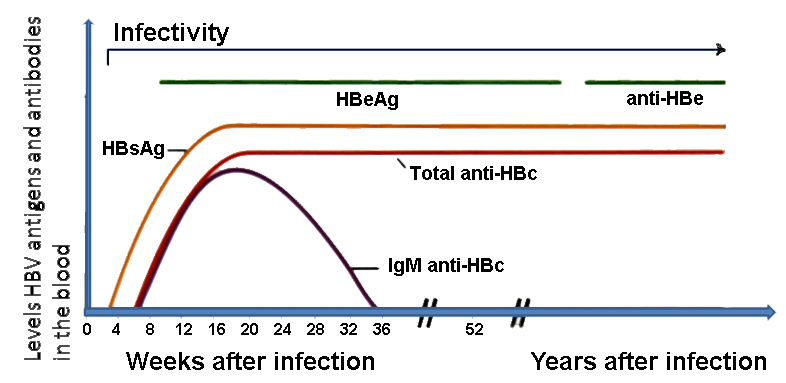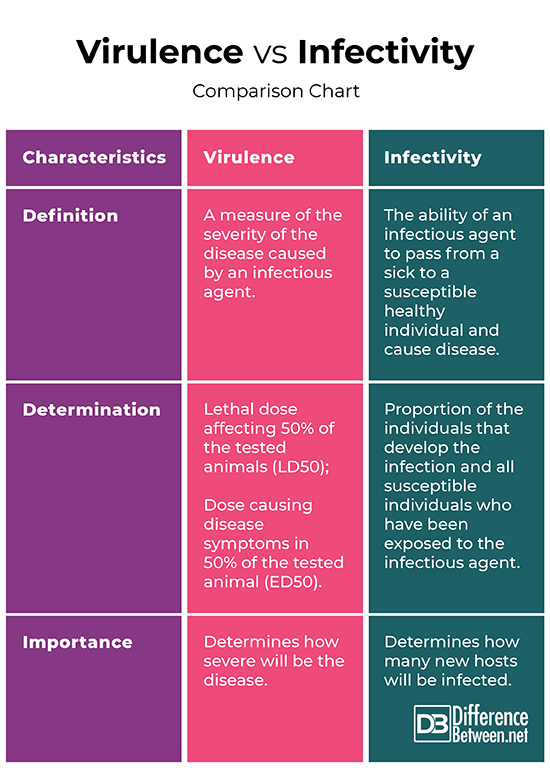Difference Between Virulence and Infectivity
The terms virulence and infectivity define different characteristics of the causative agents of infectious diseases. Infectivity is the ability of the infectious agent to pass from a sick to a susceptible healthy individual and cause disease. Virulence determines how severe will be the disease in the infected individual. Virulence and infectivity do not correlate – an infectious agent may have high infectivity, and at the same time be with a low virulence (e.g. viruses causing colds), or a high virulence and low infectivity (e.g. Ebola).

What is Virulence?
Virulence is a measure of the severity of the disease caused by an infectious agent (bacterium, virus, fungus, protozoan). The degree of virulence is directly related to the ability of the infectious agent to lead to illness despite the host’s resistance mechanisms. It is influenced by different variables such as the number of infectious agents, the way they enter the host’s body, the specific and non-specific mechanisms of host protection, and the virulence factors of the pathogen. Virulence can be measured experimentally by determining, for example, the number of bacteria needed to cause a disease or lesion in animals. Calculations of lethal dose affecting 50% of the tested animals (LD50) and the dose causing disease symptoms in 50% of the tested animal (ED50) are useful in comparing the relative virulence of different pathogens.
Virulence factors are products of the infections agents and the infectious process develops under their action. Examples of virulence factors are toxins, surface proteins that inhibit phagocytosis, and surface receptors that bind to host cells. Most pathogens have developed specific virulence factors that allow them to multiply in their host or vector without being killed by the host’s immune system. Many virulence factors are produced only by specific strains of microorganisms. For example, only certain strains of E. coli secrete enterotoxins that cause diarrhea. Virulence factors should never be considered independently of host protection. The clinical course of the disease often depends on the interaction of virulence factors with the host response. Infection begins when the balance between the virulence of a pathogen and the resistance of the host is disturbed.

What is Infectivity?
In order to ensure the survival of the species, the infectious agents need to spread continuously to new hosts. The ability of an infectious agent (bacteria, virus, fungus, protozoan) to pass from a sick to a susceptible healthy individual and cause disease is called infectivity. The infectivity of a pathogen is different from its transmissibility, which describes only the ability to pass from one host to another and is not related to the ability to cause disease.
Infectivity represents the pathogen’s horizontal transmission capacity – the spreading potential among hosts that are not a child and parent. It is measured quantitatively by the so called “incidence”. It can be calculated by the proportion of the individuals that develop the infection and all susceptible individuals who have been exposed to the infectious agent. The infectivity of a pathogen depends not only on its characteristics but also on different external factors. When a pathogen is transmitted to a new host, a disease may or may not develop depending on different factors, with the most important being the infection dose and the host’s susceptibility.
Difference Between Virulence and Infectivity
Definition
Virulence: Virulence is a measure of the severity of the disease caused by an infectious agent.
Infectivity: Infectivity is the ability of an infectious agent to pass from a sick to a susceptible healthy individual and cause disease.
Determination
Virulence: Virulence of different pathogens can be assessed based on the lethal dose affecting 50% of the tested animals (LD50) and the dose causing disease symptoms in 50% of the tested animal (ED50).
Infectivity: Infectivity is measured quantitatively by the proportion of the individuals that develop the infection and all susceptible individuals who have been exposed to the infectious agent.
Importance
Virulence: Virulence determines how severe will be the disease.
Infectivity: Infectivity determines how many new hosts will be infected.
Virulence vs Infectivity: Comparison Chart

Summary:
- The terms virulence and infectivity define different characteristics of the causative agents of infectious diseases.
- Infectivity is the ability of an infectious agent to pass from a sick to a susceptible healthy individual and cause disease.
- Virulence is a measure of the severity of the disease caused by an infectious agent.
- Virulence and infectivity do not correlate – an infectious agent may have high infectivity, and at the same time be with a low virulence (e.g. viruses causing colds), or a high virulence and low infectivity (e.g. Ebola).
- Virulence of different pathogens can be assessed based on the lethal dose affecting 50% of the tested animals (LD50) and the dose causing disease symptoms in 50% of the tested animal (ED50).
- Infectivity is measured quantitatively by the proportion of the individuals that develop the infection and all susceptible individuals who have been exposed to the infectious agent.
- Virulence determines how severe will be the disease, while infectivity determines how many new hosts will be infected.
- Difference Between Gallstones and Cholecystitis - September 5, 2021
- Difference Between Constipation and Cramping - August 4, 2021
- Difference Between Whole Genome Sequencing and Microarray - May 6, 2021
Search DifferenceBetween.net :
Leave a Response
References :
[0]Dube, H. Textbook of Fungi, Bacteria and Viruses. Mumbai: Promilla Publisher. 2007. Print.
[1]Rogers, K. Bacteria and Viruses. New York: Rosen Educational Services LLC. 2011. Print.
[2]Fields, B, and M. Knipe. Fundamental Virology. Delaware: Raven Press. 1986. Print.
[3]Image credit: https://commons.wikimedia.org/wiki/File:Chronic_HBV_v2.png
[4]Image credit: https://commons.wikimedia.org/wiki/File:H_pylori_virulence_factors_en.png
